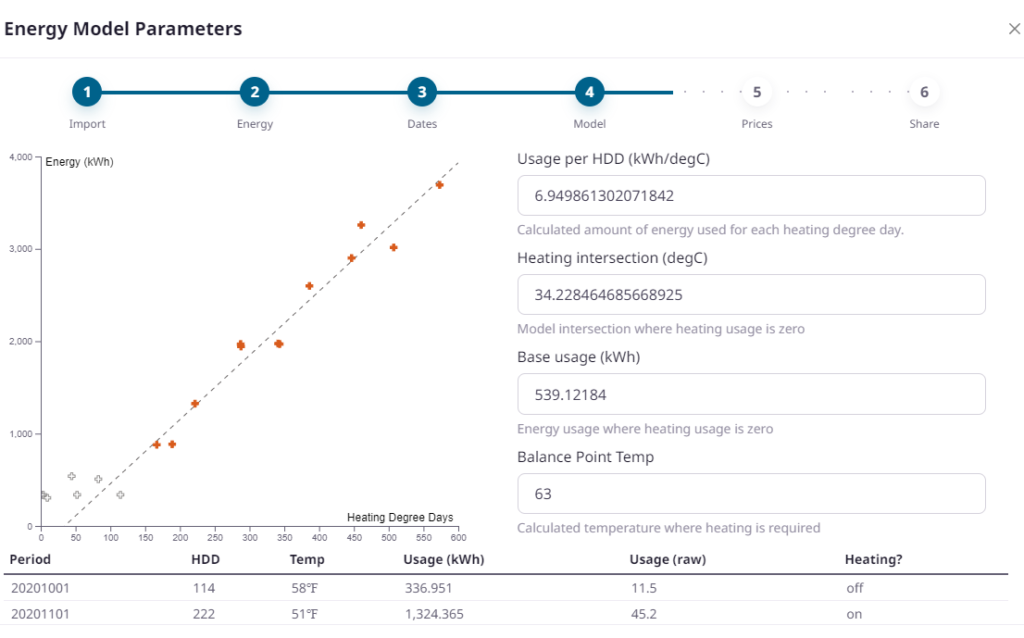We have recently released our new Winter Energy Calculator that uses the weather data for any chosen location to calculate how much energy you will use. By combining the calculated usage with historical energy prices, we then calculate how your bill will change based both on how cold the winter is and how energy prices are changing.
As we are in a time of ever increasing energy prices, even a warmer winter can have a profound effect on your bill.

Heating Degree Days – the Foundation of the Energy Calculator
There are three steps to calculating the cost of heating. The first step is to create an accurate picture of how much heating is necessary based on historical and forecast weather records. These weather records help us understand exactly how cold the winter has been and how cold it will be in the near future. This enables us to then calculate the usage an energy usage model. We calculate the energy usage using the model and then use historical energy prices to calculate the cost of the heating energy.
As the temperature drops, buildings cool off. A typical building needs heating when the outside temperature drops below about 65F (about 18C). This is the a standard temperature that represents when most people prefer some heating. 65F/18C may seem low to you but it’s worth remembering that a building that is being used will generate a small amount of heat from activities such as electrical device usage, heat from inhabitants, cooking etc. This will provide a small amount of additional ‘heating’.
As the outside temperature drops below that heating point, a building then needs heating to maintain the temperature. The colder it is outside, the more heating is required. Conceptually we can understand that a day where the temperature doesn’t get above freezing (32F/0C) needs more heating than a day where the temperature doesn’t drop below 50F (10C).
Weather and heating experts have devised a standard way to calculate how much heating is required using the concept of the number of Heating Degree Days (HDD). Heating degree days combine the difference between the outside temperature and the heating ‘base’ temperature using a formula such as:
Heating Degree Days=Base Temperature-Daily Average Temperature
Therefore if the base temperature is considered 65F or 18C and the outside daily average temperature is 50F or 10C, then the number of heating degree days is (65-50)=15F or (18-10)=8C.
Note that there are no negative heating degree days if the temperature is above the base temperature the value is set to zero (i.e. no heating required).
The daily average temperature can be calculated in a number of ways – the average of the hourly temperatures or, if only the high and low temperatures are available, then the average of the high and low temperatures. In many cases the high temperature may be above the heating point but the low below it. For example an autumn high of 70F ( 21C) and low of 50F (10C). Heating will not be necessary during the day, but it may be during the colder night time period.
Other algorithms are available for calculating Heating Degree Days, and the related Growing Degree Days and Cooling Degree Days. See our full Degree Day Weather API for more information.
The Winter Energy Calculator provides the information on the total heating degree days. For example, in Washington, DC, USA, where there are hot summers and colder winters, we see a well defined heating season during the winter with no heating in the summer:

Other locations, such as London, UK have a much longer heating period but the temperatures don’t get as cold in the winter. In addition, the temperature in the summer can also be quite close to requiring some heating.

We can extend the daily heating degree days to the full winter season by simply summing up all the heating degree days for the winter. This total amount of heating degree days can be used to then calculate how much energy is needed. If we look at the cumulative heating degree charts for the above locations, we see how the total amount of heating degree days increases throughout the season.
Note how the colder, but shorter winter of Washington, DC with it’s fast increase in HDD from November to March compares to the longer, but warmer winter in London where the increase is much more gentle from September to May.


Now we have an understanding how we can use the weather data records as a way to calculate how much heating is required for a particular winter. We can now create a way to calculate how much energy will be used to heat a building during these winters.
Creating an energy usage model
To be able to calculate the energy needs of a building, we need to be able to take the winter heating degree days and use those to calculate the heating energy needs.
The energy used to heat a building depends on many factors including the size of the building, the materials used and the ability for heat in the building to escape. The quality of the insulation, whether the building is a standalone building or attached to other buildings as in the case of flats, apartments or terraced/row housing will make a tremendous difference in the heating needs of a building.
Clearly there is no one-size-fits-all approach so the technique that the calculator takes is to create an energy model based on past energy usage and historical weather. You can import historical usage into the calculator and the calculator will create a model by comparing your usage to historical weather.

A typical weather model will create a mathematical function of the form Energy=f(heating degree days). In our initial release we are typically creating linear models which we have found to fit the data well. As we gather additional data, we may apply more complex model techniques so watch this space!
If you don’t have access to historical energy records, then we include a set of energy usage profiles for you to use. We are hoping that users will help us expand this list of typical profiles using crowdsourced energy model.
Calculating the price of heating
Now we can calculate the energy requirements for a particular building based on the heating needs, we can now calculate the cost of purchasing that energy.
To do this we look at the energy usage and the historical energy prices for that location. The final pricing result estimates the price for a user buying energy for that location for that month on the open market.
Energy pricing approaches do vary quite considerably. Many providers offering techniques to smooth out or fix prices over the year (for example paying more in the warm summer months to avoid very high bills during the winter). In addition taxes, regulatory fees and other fixed fees may not be included in the estimated price.
However the price that the calculator produces is a good guide to how much you will pay for your heating energy over time.
Help us make the calculator better – crowd sourcing winter heating model
The Winter Energy Calculator relies on quality data to represent the temperatures, energy usage and price of heating a building. We are using our own Weather API for sourcing the temperature and heating degree day information. We need your help in training the energy usage model and identifying local pricing that applies to you, no matter what type of energy you use to heat your building.
Please consider uploading your historical usage in the energy model calculator – you will get a better picture of how the weather will effect your heating. In addition, if you share your data, we can then incorporate the data into more profiles so future users will be able to benefit from your help.
We will be updating the Winter Energy Calculator throughout the coming months as we receive feedback so please contact us with your feedback or suggestions!
Questions or need help?
If you have a question or need help, please post on our actively monitored forum for the fastest replies. You can also contact our Support Team.

